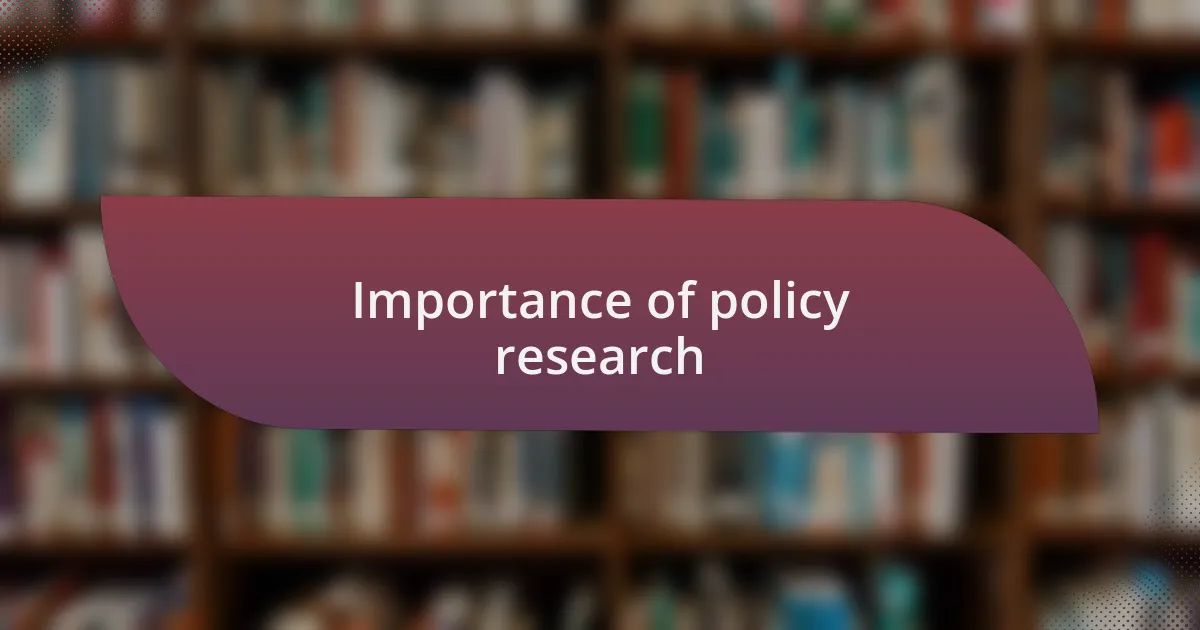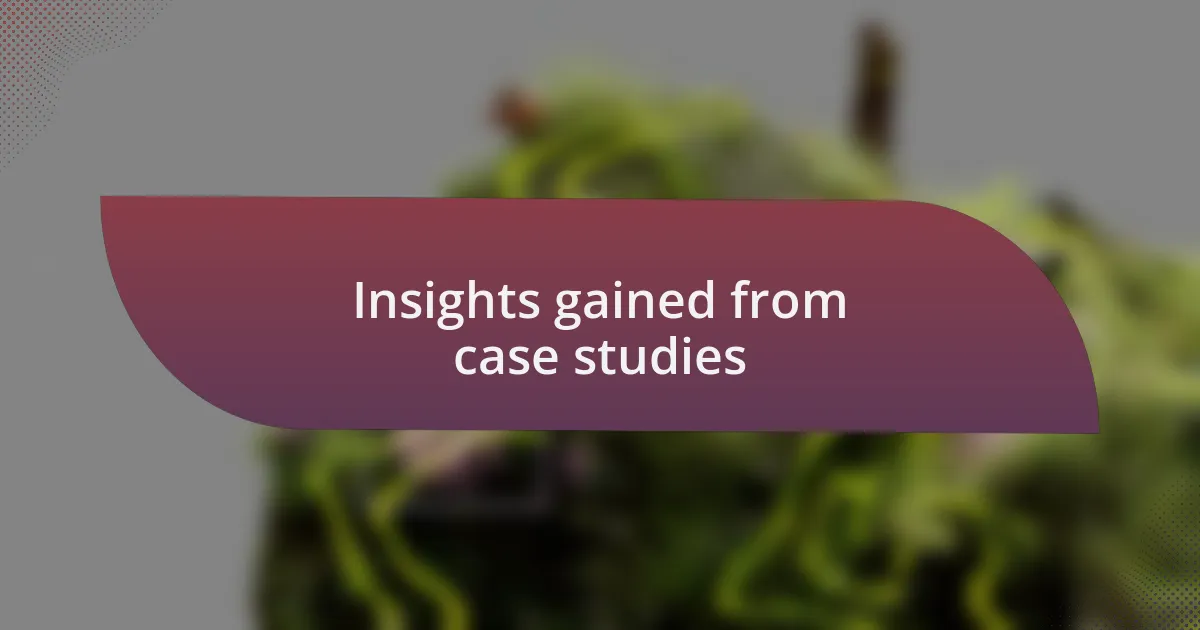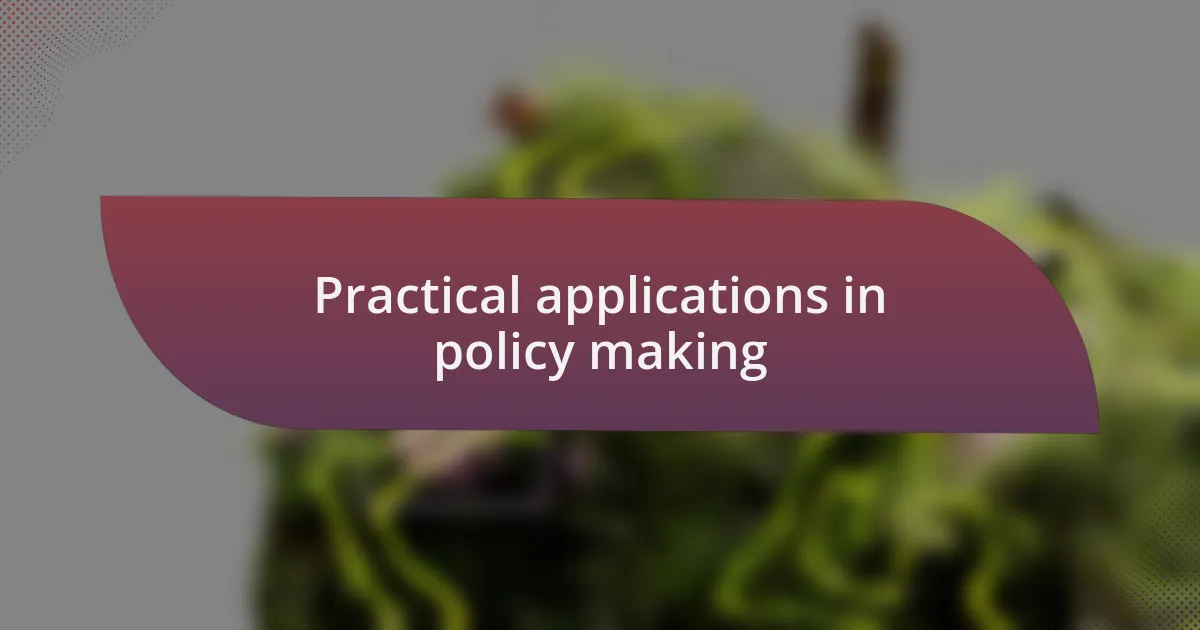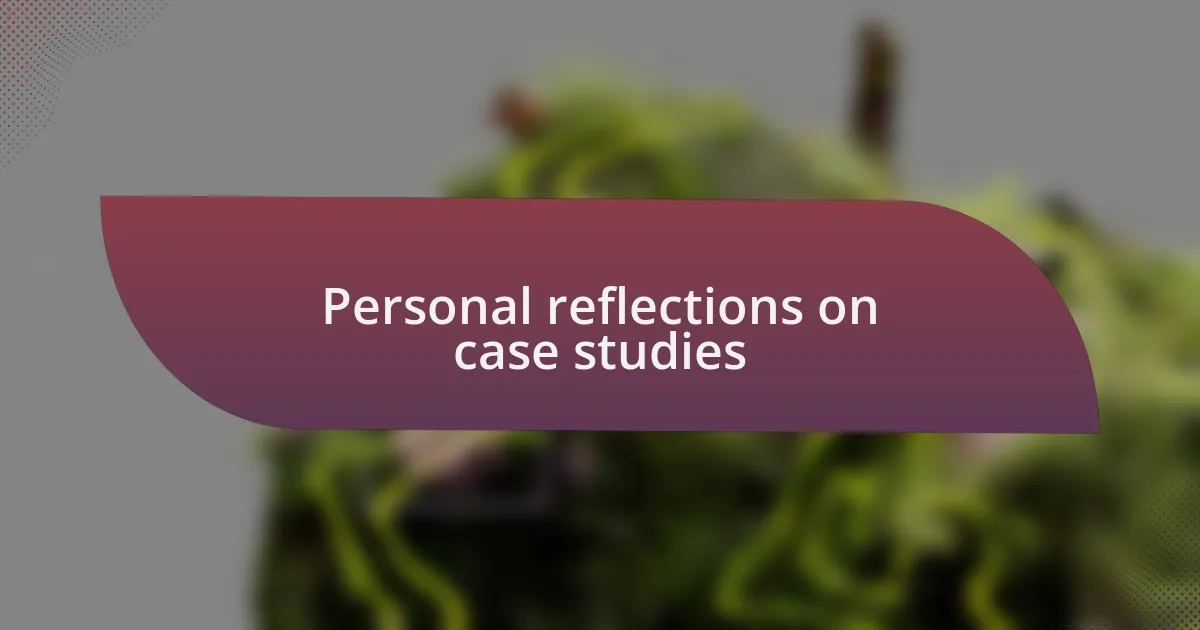Key takeaways:
- Case study research integrates quantitative and qualitative data, revealing deeper insights into human behavior and policy implications.
- Effective policy research stems from community engagement, ensuring that solutions address real-world challenges and foster informed dialogue.
- Key components of case studies include context, diverse methodologies, and thoughtful data analysis, all of which enhance understanding and critical thinking.
- Personal narratives and adaptability in research are vital, as they illuminate human experiences behind statistics and allow for responsiveness to new findings.

Understanding case study research
Case study research is a powerful method that dives deep into real-world contexts, providing nuanced insights that broader studies often overlook. I remember when I first engaged with a case study; it felt like peering through a window into the complexities of human behavior and institutional dynamics. It raised an important question for me: how can we truly understand the implications of policies without examining the stories behind them?
What I’ve found fascinating about case study research is its ability to blend quantitative and qualitative data, allowing for a rich tapestry of evidence. For example, while working on a project analyzing educational policies, I collected numerical data alongside personal interviews with teachers. It was revealing to see how those statistics told one story, while the teachers’ voices added layers of emotion and context, creating a complete picture. Have you ever considered how statistics alone can’t capture the lived experiences that shape those numbers?
Through my experiences, I’ve come to appreciate the iterative nature of case study research. Each case often leads to new questions, encouraging a mindset of continuous exploration. I vividly recall a project where initial assumptions were challenged, revealing unexpected outcomes. This process of discovery not only deepened my understanding but also solidified my belief that real-life implications should always be at the forefront of our research endeavors.

Importance of policy research
Policy research plays a crucial role in shaping effective and equitable governance. I often reflect on my experiences working alongside policymakers and how data-driven insights guided their decisions on pressing issues like healthcare and education reform. It struck me that the more robust the research backing these policies, the better they addressed the actual needs of the community. Have you ever noticed how poorly informed policies can lead to unintended consequences?
One of the most striking observations I’ve had is how policy research can serve as a bridge between theory and practice. I recall a time when I was involved in researching environmental policies. By collaborating with local stakeholders, we uncovered community-driven solutions that formal reports had missed. This reinforced my belief that actively engaging with those affected by policies ensures that research addresses real-world challenges. Isn’t it enlightening when the voices of the community shape the policies that govern them?
Moreover, the importance of policy research transcends just providing statistics; it cultivates a culture of critical thinking and informed dialogue. When I facilitated workshops on policy analysis, I was surprised to see how effectively participants from diverse backgrounds engaged with data. They challenged assumptions and contributed unique perspectives that enriched our discussions. Can you imagine the transformative impact if more research initiatives fostered such inclusivity?

Key components of case studies
Case studies are multifaceted and typically include context, data collection methods, and analysis. In my experience, providing a detailed background helps illuminate not just the problem but also the environment in which it exists. I once tackled a case study on urban development and found that weaving in local history and demographics was crucial for understanding the stakeholders involved. Have you ever tried to solve a puzzle without knowing what the picture looks like?
Another vital component is the methodology employed in the study. I remember feeling inspired when I learned to use various data collection techniques, such as interviews and surveys, to gather rich, qualitative insights. This blend of methods offers a comprehensive view of the issue and invites readers to engage critically with the findings. Have you ever analyzed a situation and wondered if there was more beneath the surface that could change your understanding?
Lastly, the analysis and interpretation of the data form the heart of any case study. I have often marveled at the stories data can tell when analyzed thoughtfully. In one assignment, I discovered that data visualization significantly sharpened the impact of my findings. It made me ponder: how often do we overlook the power of storytelling in data, and could our narratives be stronger if we embraced this component more fully?

Insights gained from case studies
Case studies have an incredible ability to reveal insights that might otherwise remain hidden in broader analyses. I remember a specific case focusing on healthcare policy that unveiled the unintended consequences of a well-intentioned initiative. It made me realize just how nuanced policy implementation can be. Have you ever paused to consider how a decision meant to support one group might inadvertently harm another?
Through my experience with different case studies, I’ve come to appreciate the power of context. One project examined how community engagement influenced the success of an environmental policy. By engaging with local residents and understanding their perspectives, I learned that the most effective solutions often come from those most affected by the issues at hand. Isn’t it fascinating how sometimes the answers lie in the very communities we aim to serve?
Moreover, case studies often challenge our assumptions and prompt critical thinking. I once analyzed a case related to education reform, where the data contradicted the prevailing beliefs about student performance. This experience reinforced my belief that questioning the status quo can lead us down new pathways of understanding. Have you ever had a moment where you had to rethink your stance because the evidence told a different story?

Practical applications in policy making
When it comes to practical applications in policy making, case studies serve as a vital bridge between theory and practice. I recall reviewing a case on urban development, where the integration of public transportation planning transformed an entire neighborhood. The success of this initiative reminded me that real-world examples are invaluable for informing policy choices. Have you ever thought about how one successful policy might inspire similar initiatives elsewhere?
Often, decision-makers benefit from detailed case studies that highlight both successes and pitfalls. For instance, while examining a case on renewable energy policy, I noticed that inadequate stakeholder involvement led to project delays. This insight has shaped my approach to advocacy; it reinforces the importance of collaboration and communication in crafting effective policies. Isn’t it enlightening to realize how the failures of others can guide us to make more informed decisions?
Finally, I’ve seen how case studies can illuminate the long-term impacts of policies, which is crucial for sustainable development. I once worked on a project assessing the effects of a tax incentive for green businesses. The findings revealed not just economic benefits but also community enrichment and environmental improvements. This discovery sparked my passion for promoting policies that yield multifaceted benefits. Have you considered how long-lasting effects can sometimes be overlooked in the rush to implement new policies?

Personal reflections on case studies
As I reflect on my experiences with case studies, I often find myself amazed at the depth of understanding they provide. I once analyzed a case focused on mental health policy, which revealed how community-centered approaches significantly improved care access. It struck me how easily policymakers can overlook the personal stories that drive statistics, igniting a deeper appreciation for the human side of policy.
One thing I’ve learned is the power of storytelling in case studies. During a discussion about education reform, I remember a heartfelt account from a teacher whose innovative classroom practices sparked a movement in their district. That story made me realize that behind every data point lies a narrative that can shift perspectives and inspire change. How often do we let the human element get lost in bureaucratic language?
Throughout my journey, I’ve also come to value the lessons learned from both triumphs and failures. I once studied a case on a failed healthcare initiative, which highlighted the critical need for flexibility in implementation. This experience taught me that setbacks can be rich sources of learning; they’re not just obstacles but opportunities for growth. Have you ever changed your perspective after witnessing a policy initiative fall short?

Lessons for future research endeavors
Diving into future research, I recognize the importance of interdisciplinary collaboration. During a project on environmental policy, I teamed up with experts from economics, sociology, and communications. This collaboration not only enriched our findings but also illuminated the multifaceted nature of policy challenges. Have you ever found that collaborating with someone from a different expertise opens up entirely new avenues for thought?
Another valuable lesson I’ve learned is the significance of incorporating diverse stakeholder perspectives. In my work analyzing a housing policy case, I engaged with both residents and policymakers. Their contrasting views uncovered nuances that quantitative data alone couldn’t reveal. It left me wondering: how often do researchers fully consider the voices that will be most affected by their policies?
Lastly, I’ve realized that adaptability stands as a cornerstone for effective research. Reflecting on a case study examining the impact of remote learning during the pandemic, I saw firsthand how quickly circumstances can shift. The ability to pivot and reassess approaches in response to emerging findings is essential. It begs the question: are we truly prepared to adjust our research strategies as new information comes to light?